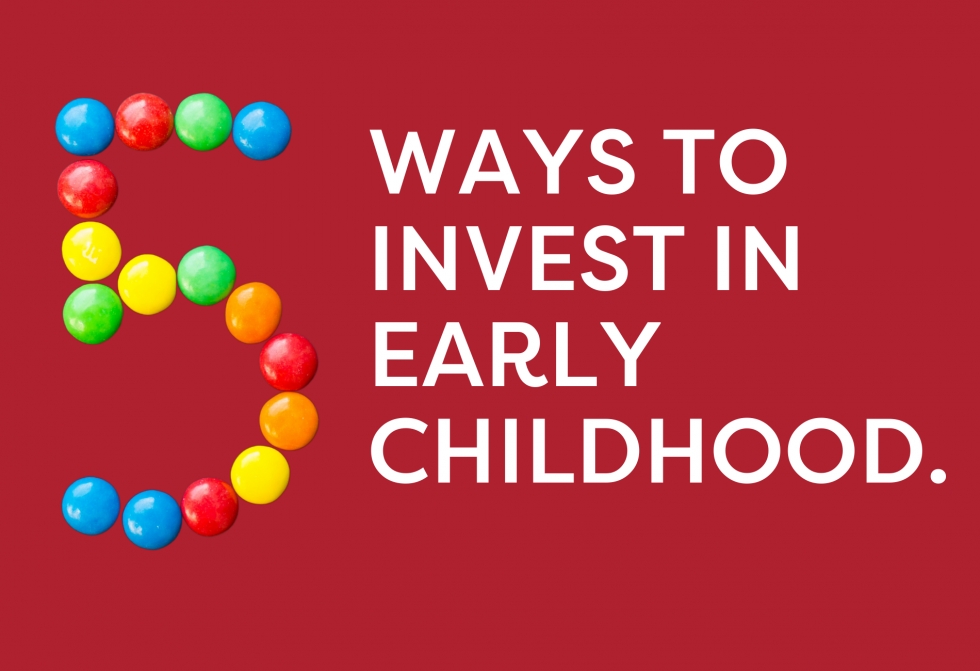“The way we [invest in Utah] is by focusing on our kids, giving them the best opportunities, the best resources at the earliest possible time...to help them to live better, happier and less trauma-filled lives, while also saving taxpayer money by dealing with these issues early on, before they lead to bigger problems down the road.”
Those words above, spoken by our new Governor, when he was serving as the Chair of Utah’s Early Childhood Commission in his capacity as Lieutenant Governor, capture our sentiments at Voices for Utah Children exactly!
We agree with these words, and call on all our state leaders to put them into bold action. With the coronavirus pandemic revealing the serious cracks in our state’s education system and child care sector, we need strategic investment big more than ever.
Currently, Utah lags behind most other states with regard to investment in early care and learning support for Utah families with young children How do we lag behind, you ask? Learn more here!
Taking these five steps would constitute great progress in Utah’s championship of early education – and also promise the greatest return on investment of any educational reform.
1. Appoint a Cabinet-level Early Childhood Investment advisor.
Early education is very different from primary, secondary and higher education. Investment in early childhood care and learning requires a dedicated focus. This advisor should act as the full-time staff director of the Early Childhood Commission, which is now chaired by Lieutenant Governor Deidre Henderson. Why would having a full-time commission director make a difference? Here's why.
2. Reimburse full-day kindergarten at a full Weighted Pupil Unit.
Utah has one of the nation’s lowest rates of participation in full-day kindergarten. This is due to lack of access, not family preference. In areas where full-day kindergarten is offered, Utah families overwhelmingly participate. Okay, what's a "weighted pupil unit" and why is it important? And by the way, what is Utah's current level of participation in full-day kindergarten?
Currently, local education authorities (LEAs) have to cover the cost of full-day kindergarten themselves – making access inequitable and unreliable. You can change this by budgeting a full WPU for full-day kindergarten programming, wherever families want it and LEAs can offer it. We've come to the conclusion that Utah is ready for more full-day kindergarten, based partly on these key reasons.
3. Build a statewide High-Quality School Readiness (HQSR) mixed-delivery system.
Utah’s only state-level investment in high-quality preschool hasn’t grown since it began more than seven years ago. Arguments over assessments and oversight have stymied expansion. It’s time to put the turf battles aside and get serious about extending performance-based preschool grants to more schools, child care providers, and community programs. Um, what is a "mixed-delivery system" for preschool? And what is the state's current investment in preschool?
4. Use federal COVID relief money - and after that, state funding - to stabilize, strengthen and build Utah's childcare system for the future.
Working families need their kids to be safe, cared for and progressing developmentally while breadwinners are at work. In the past year, Utah has received a flood of emergency funding from the federal government to make sure Utah families continue to have access to safe, quality childcare throughout the pandemic - and beyond the recovery. Utah should waive parent co-pays for families receiving childcare subsidies, pay childcare providers based on the enrollment (not attendance) of children using subsidies, and continue its successful Operations Grant program. When the federal relief funding runs out, Utah should replace it with state dollars. How do childcare subsidies work, and why are these changes important?
5. Support regional coordination to improve kindergarten transitions.
Utah’s sprawling, mixed-delivery early childhood ecosystem can’t be managed by state administrators in Salt Lake City. Parents, community leaders, child care providers and educators need support to organize locally, and coordinate services at the city, county and school district levels. Utah should increase, significantly, its financial support of regional Child Care Resource & Referral (CCR&R) agencies, to staff up efforts at regional coordination. What, precisely, do you mean by a "sprawling ecosystem?"
We loved how Governor Cox and Lieutenant Governor Henderson talked about educational opportunity, early education and education equity on the campaign trail.
“It is absolutely critical that education funding is our first and foremost priority,” said then-candidate Cox on the campaign trail. “We have to make sure that kids in rural Utah, as well as the west side of the Salt Lake Valley, get the same opportunities, the same education as kids in Park City.”
We could not agree more heartily. Park City has full-day kindergarten, public and private preschool, community investment in child care access, and an Early Childhood Alliance that supports regional coordination of programs for young children. Governor Cox is right: every Utah community deserves the same - and they will need bold state leadership to support them in getting there.
If Utah is serious about every Utah family having equitable access to these same opportunities, these five steps will be central to our work in the next four years.
Answers to Your Totally Common Sense Questions
About Early Childhood Care & Education in Utah
How do we lag behind other states?
As a state, Utah contributes very little funding toward important early childhood interventions, including: home visiting programs, preschool (including Head Start and Early Head Start), child care subsidies, and full-day kindergarten. Where these programs exist, they are made possible almost entirely by federal funding.
Many other states extend the impact of federal funding for home visiting, Head Start, child care subsidies and other early childhood interventions by adding their own state dollars to grow those programs. Utah does not. As a result, fewer families can benefit from these programs in Utah communities, than would be possible with additional state funding. (Okay, take me back to where I was!)
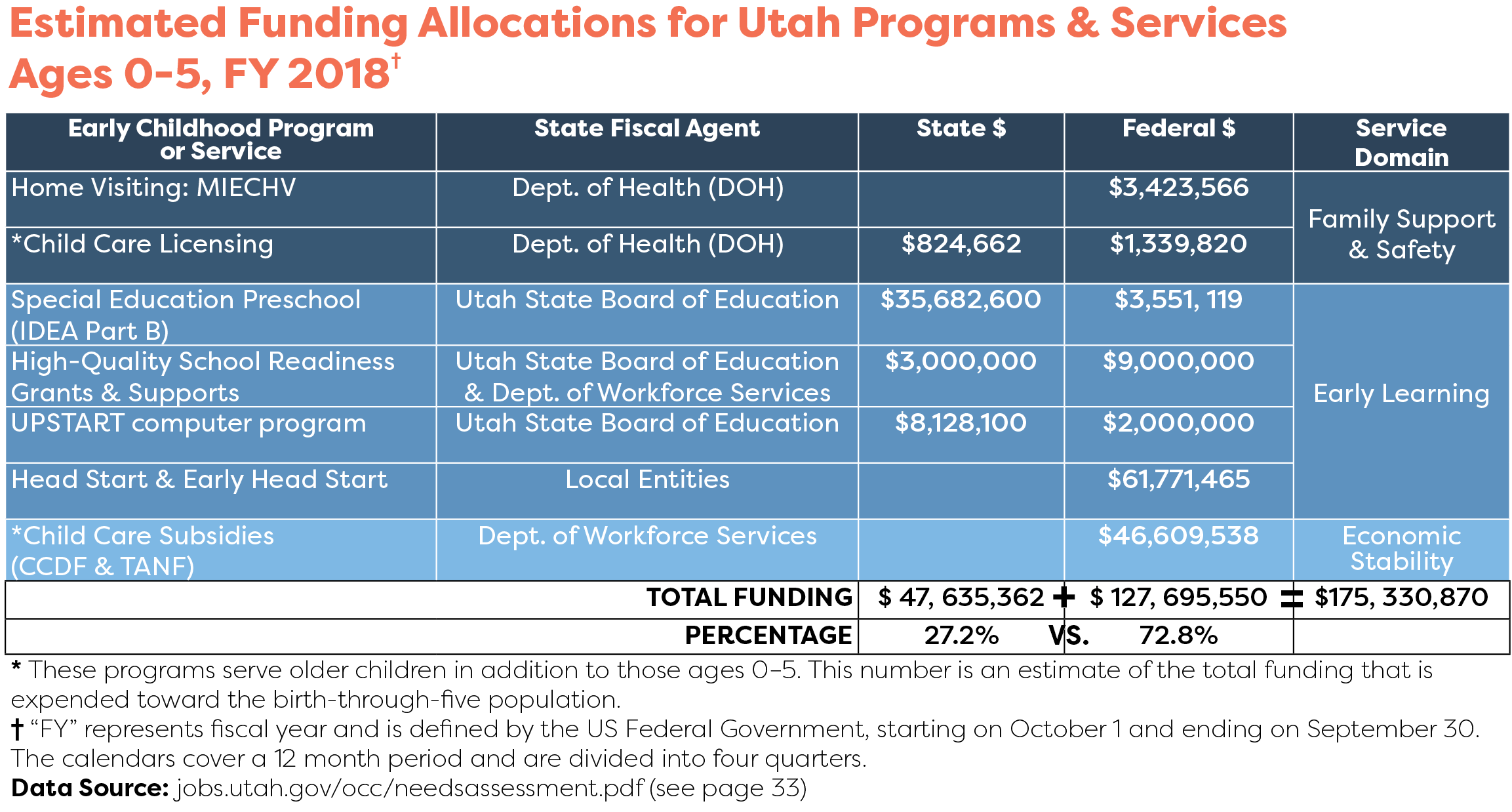
Why would having a full-time commission director make a difference?
When Utah’s Early Childhood Commission was proposed via legislation by Rep. Lowry Snow and Sen. Ann Millner during the 2019 General Session, the original concept contained funding for a full-time staff member to support the functioning and forward momentum of the new Commission. When the bill finally passed, this funding was removed. Since then, staffing for the Commission has bounced between the Lieutenant Governor’s Office and the Office of Child Care (in the Department of Workforce Services), with those responsibilities always falling to a hardworking public servant already tasked with multiple other critical education and child care projects.
One persistent issue with the coordination and alignment of Utah’s early care and education system is that there is no single entity, agency or individual committed to that effort.
Leadership, intention and single-minded commitment is needed to shepherd Utah’s early care and education system to the next level of improvement; currently, all stakeholders at the Early Childhood Commission table must juggle their early childhood work with multiple other state government responsibilities. (Thanks. Now take me back to where I was!)
What is a "weighted pupil unit" and why is it important?
A “weighted pupil unit” or WPU is the designated funding allocation provided by the state legislature to support the education of a single Utah public school student. Each year, the state legislature and the executive branch (including the Governor’s Office and the Utah State Board of Education) come to an agreement as to how many state dollars will be provided to each school, through its local education authority (or LEA, which can be a school district or a charter school) for each student enrolled for the next school year.
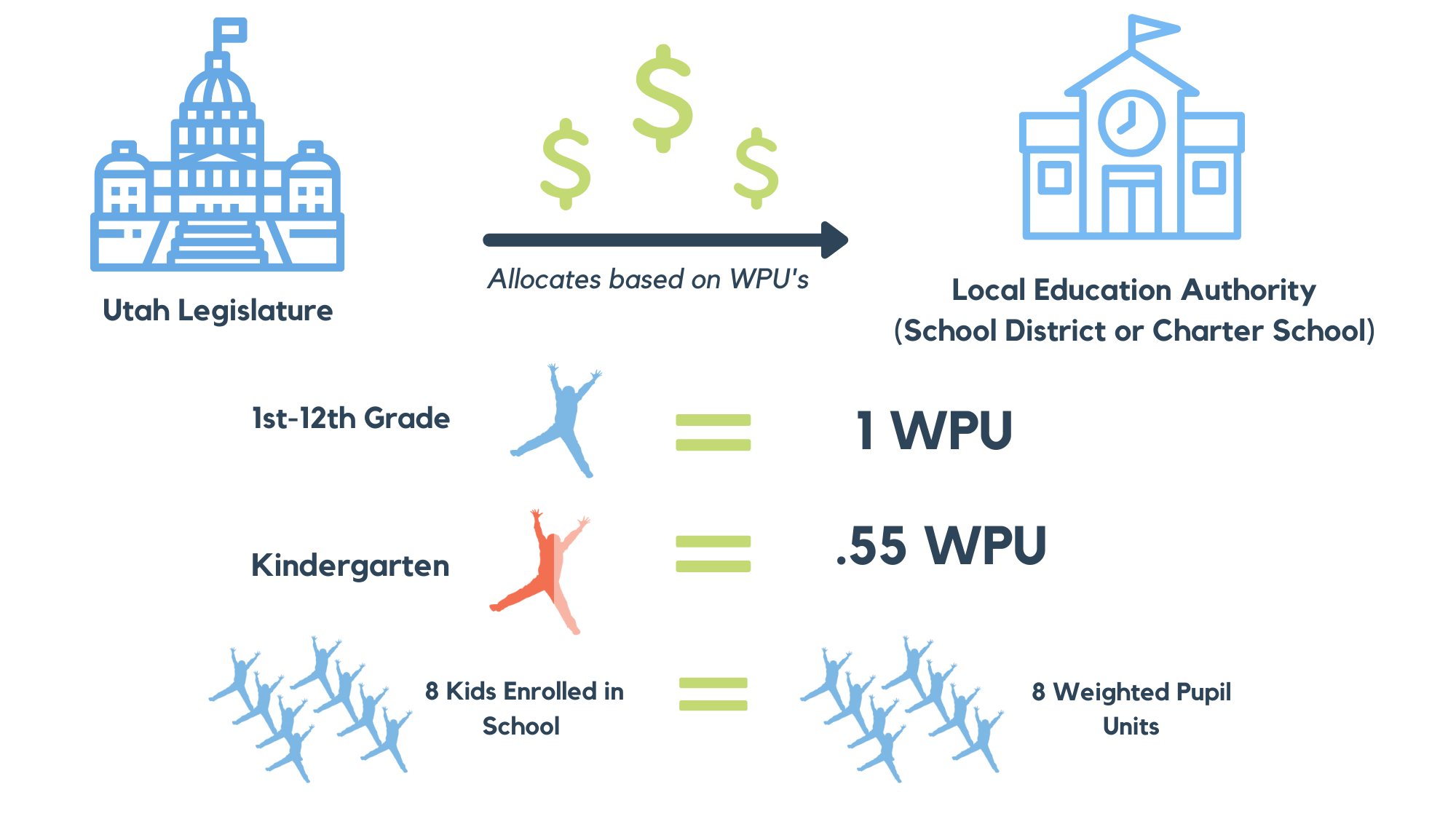
Currently, Utah ranks dead last in the nation - behind all others states and the District of Columbia - with regard to “per pupil funding.” This ranking has remained unchanged for years.
The state gives each school district only 55% of a weighted pupil unit for each enrolled kindergartner. All state-funded LEAs are required by law to provide at least one half day (two or more hours) of kindergarten education for interested families. (Okay, take me back to where I was!)
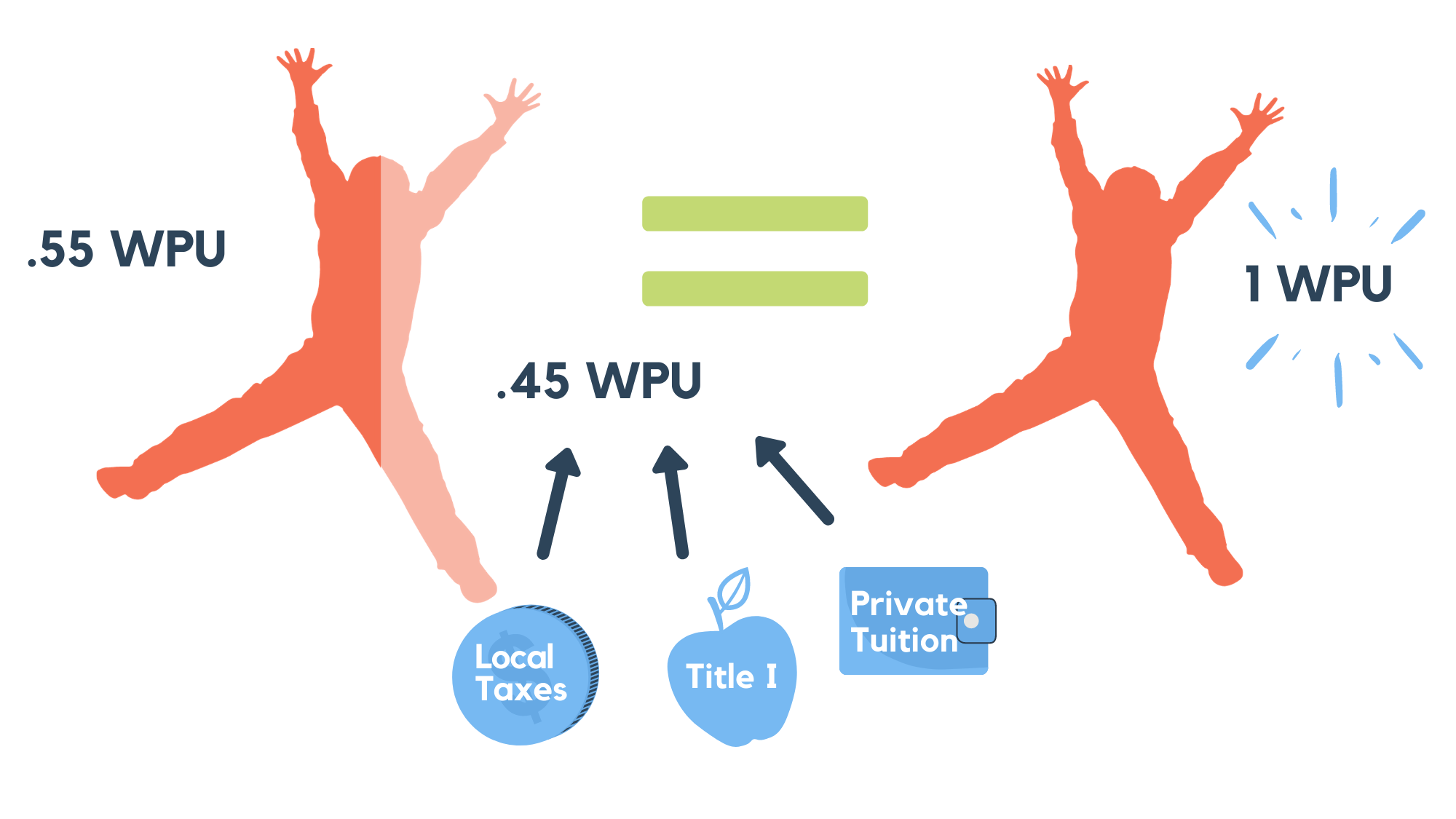
What is Utah's current level of participation in full-day kindergarten?
Across the United States, approximately 80% of kindergarteners attend a full-day kindergarten program. This figure has grown dramatically over the past twenty years (approximately 56% in 1999).
In Utah, however, as recently as 2019, only 20% of kindergarteners attended full-day kindergarten (with an additional 4% attending an “extended” day of schooling, such as an additional 45 minutes or more of academic intervention on top of the traditional half day of kindergarten education). (Thanks. Now take me back to where I was!)
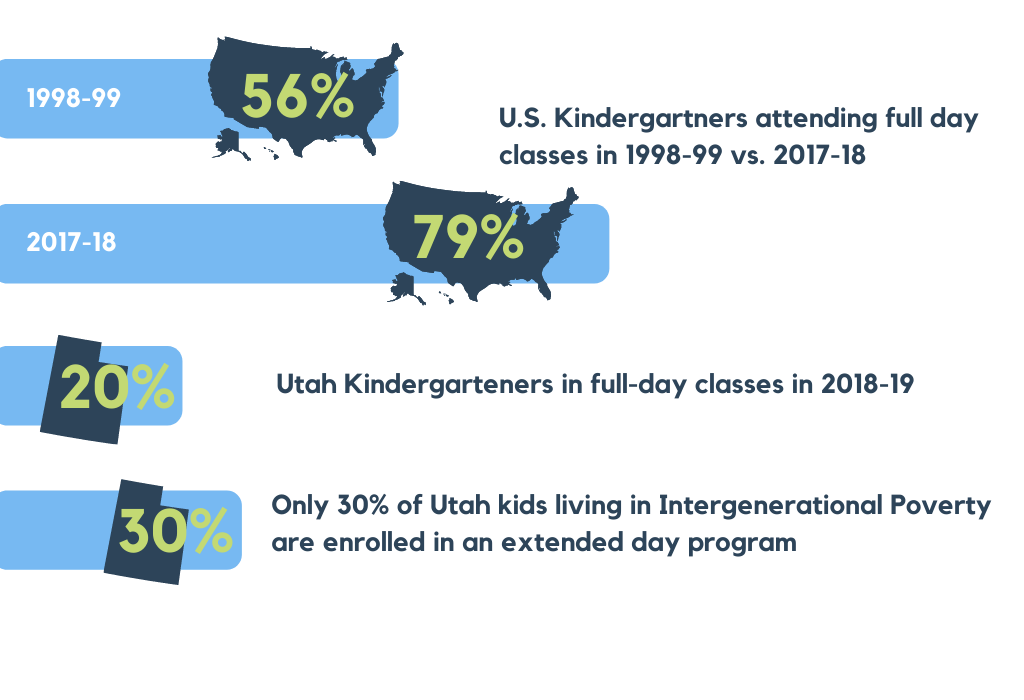
Indications that Utah is ready for more full-day kindergarten access.
In our report, “Three Things Utah Can Do to Ensure Right-Sized Access to Full-Day Kindergarten,” released in February 2020, we noted the following:
- In response to both parent interest and educator confidence in full-day learning interventions, multiple districts and individual schools have tapped federal and local funding (in lieu of sufficient state support) to open more classrooms for a full-day of kindergarten instruction;
- In every school district that has expanded access to full-day kindergarten (including Carbon SD, Rich SD, Ogden SD, Murray SD, Washington County SD, Grand SD, Granite SD, Salt Lake SD and Canyons SD), participation has been robust; and
- Families living in districts offering little or no access to full-day kindergarten in their neighborhood school, admit to registering their kindergarten-aged children in a different district, in order to enroll their child in a full-day program. (Okay, take me back to where I was!)
What is a "mixed-delivery system" for preschool?
A “mixed-delivery system” for preschool programming is one where a variety of different preschool providers are part of delivering preschool opportunities to families. A “mixed-delivery system” includes preschool classrooms in: public elementary schools; private child care centers; and community-based non-profit programs (such as the YMCA). In some mixed-delivery systems in other cities, counties and states in the U.S., government funding is used to provide access to preschool for families, who are allowed to select which type of preschool program (school-based, community-based or private provider) is the best fit for their child. (Thanks. Now take me back to where I was!)
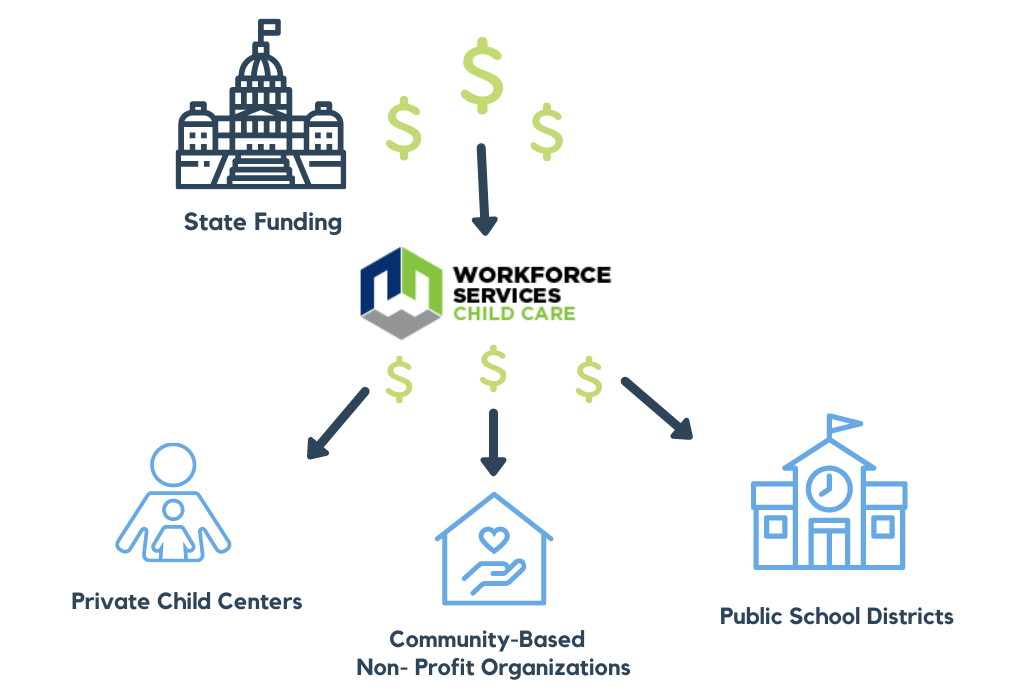
What is the state's current investment in preschool?
The only state funding explicitly available for preschool programs is the amount allocated annually, since 2014, for the High Quality School Readiness (HQSR). The program started with an allocated $7.5 million of baseline funding; there has been no increase since. This program was a state-funded continuation of a Pay-For-Success initiative pioneered by the United Way of Salt Lake in 2013. Under the HQSR program, school districts and private child care providers can apply for a performance-based grant to fund preschool “seats” in their classrooms. Since 2014, approximately 5,000 Utah preschoolers have participated in the program.
The National Institute for Early Education Research (NIEER) produces an annual report on which states in the U.S. have state-funded preschool programs. With the exception of the 2019-2020 report, each year, Utah’s state-funded preschool program has failed to meet the minimum criteria to be included in NIEER’s annual report. (Okay, take me back to where I was!)
How do childcare subsidies work, and why are these changes important?
Thanks to the federal government's Child Care and Development Fund, Utah is able to help low-income parents cover the cost of childcare while they are working, looking for work or training for work. During the current budget year (from July 1, 2020 to June 30, 2021), Utah will receive approximately $139 million in CCDF money, including an additional $40 million in one-time CARES Act funding to help with pandemic-related child care support. The federal government requires that at least 70% of this amount must be used to help families directly, through child care subsidies.
This additional funding, with more COVID relief dollars on the way, has allowed Utah to make several positive changes in its childcare subsidy program. These changes have made it possible for more families to get help paying for childcare services. The changes have also helped stabilize and support childcare providers, whose businesses have been hit really hard by the pandemic.
In normal times, a family must make less than 56% of the state median income (SMI) to qualify for a childcare subsidy. That is $44,016 for a family of four people (or 168% of the federal poverty level). Thanks to COVID relief funding, families that make up to 85% of SMI to qualify for help. That is $65,498 for a family of four people. Child care subsidies are paid directly to a childcare provider when a child enrolls. In normal times, Utah only pays for each day that the child attends childcare. This means subsidies can be an unstable and unreliable source of income for providers. Thanks to COVID relief funding, Utah now pays childcare providers based on enrollment - so providers don't suffer financially when families have to quarantine, stay home from work or become ill. We think these changes, and others made possible by increased investment in the last year, should be permanent. This will help more families in Utah access safe, affordable and quality childcare. (Thanks. Now take me back to where I was!)
What makes Utah's early childhood care and education system so "sprawling" and difficult to coordinate?
Currently, several different federal, state and local entities (including private businesses and non-profit organizations) are responsible for providing early care and education programs for Utah families with young children.
Office of Child Care (OCC)
The Office of Child Care (OCC), in the Department of Workforce Services (DWS), provides child care subsidies to help thousands of low-income Utah families afford child care. In addition to state licensing requirements, OCC has a new “Child Care Quality System” that gives participating child care providers a designated quality level, based on a number of different factors. The Office of Childcare also manages the High-Quality School Readiness (HQSR) program funded by the legislature, through which a limited number of three- and four-year olds are able to participate in structured preschool programs.
Office of Child Care Licensing (CCL)
The Office of Child Care Licensing (CCL), in the Utah Department of Health (UDOH), is in charge of making sure child care providers maintain a basic level of health and safety in their child care businesses.
Utah State Board of Education
In addition, the Utah State Board of Education has guidelines for preschool programs that are provided through the public school system. Those guidelines are separate from the guidelines schools and child care providers must follow if they are participating in the state’s High Quality School Readiness (Preschool) performance-based grant program.
Private Preschool Providers & Home-Based Preschool Programs
There are also many private preschool providers throughout the state who are not required to be licensed by the Office of Child Care Licensing and who are not governed by the Utah State Board of Education. These are the kind of home-based preschool programs that provide only a couple of hours of instruction per day, for families who are willing and able to pay privately.
Head Start and Early Head Start Programs
There are also dozens of Head Start and Early Head Start program sites throughout the state, which adhere to a completely different set of standards, set by the federal government, and which are largely independent of any state agency.
(Whew, that's enough! Take me back to finish the letter, please.)

